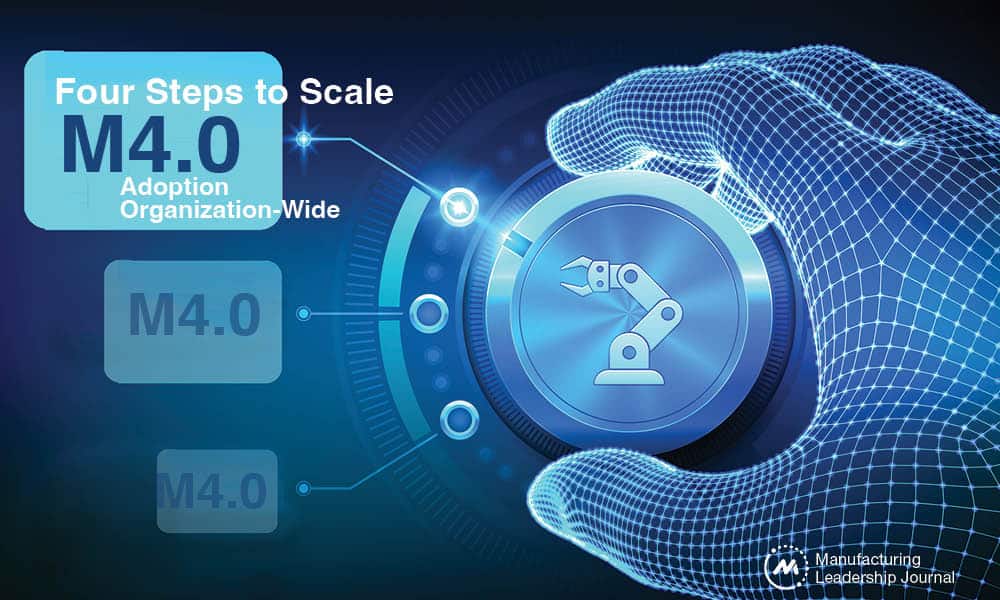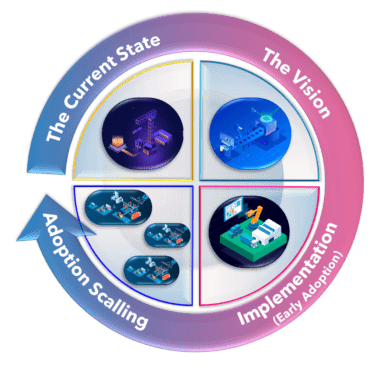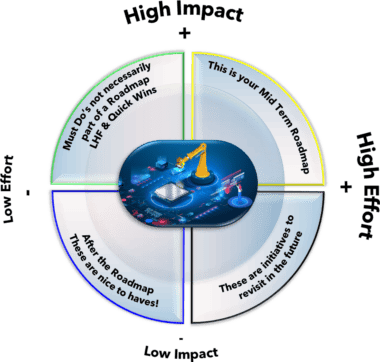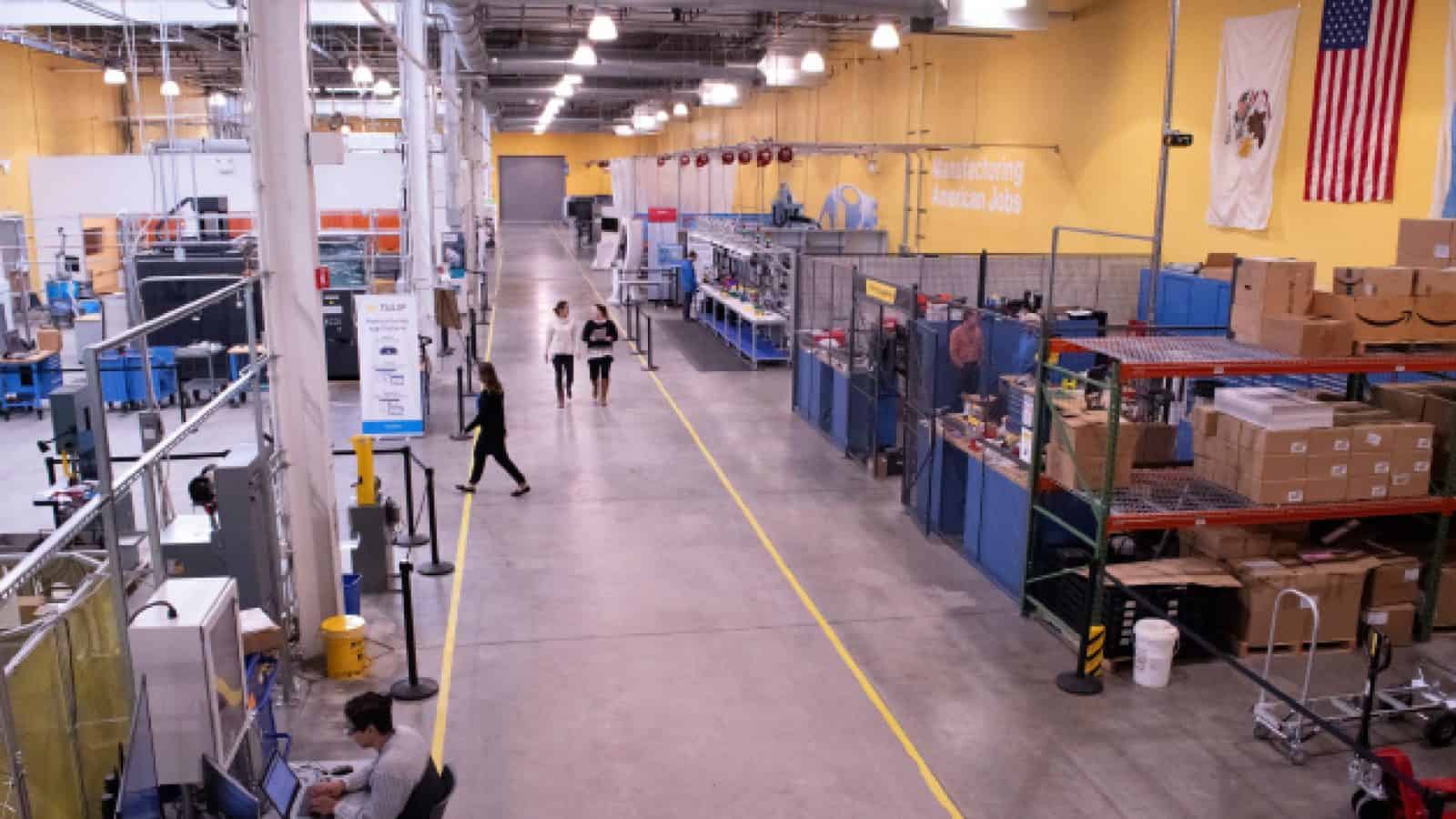Four Steps to Scale M4.0 Adoption Organization-Wide

Want to reap Manufacturing 4.0’s benefits at scale? Let this four-step roadmap lead the way.

TAKEAWAYS:
● M4.0 has significant implications for industrial operations, integrating advanced technologies with traditional manufacturing processes.
● Adopting and scaling M4.0 requires an understanding of best-practices to avoid common mistakes and improve outcomes.
● A successful scaling process begins by examining the current and desired future state.
Why follow these steps?
The M4.0 transition is more than just the adoption of new technologies; it is a complete reimagining of design, production, and delivery methodologies. Successfully navigating this transformation requires a well-structured roadmap, a robust maturity model, and an effective transformation framework.
 Adopting M4.0 is more nuanced than meets the eye. Following best practices at each phase helps to avoid these common mistakes when scaling M4.0’s adoption:
Adopting M4.0 is more nuanced than meets the eye. Following best practices at each phase helps to avoid these common mistakes when scaling M4.0’s adoption:
- Failing to fully integrate: M4.0 is not just about technological upgrades; it is about how these technologies are integrated into an organizational structure and leadership. Good use cases become great when embedded into a broader, cohesive strategy.
- Overlooking strategy: M4.0 success hinges on a culture of innovation and collaboration. Avoid the mistake of letting promising use cases stall at the pilot stage due to a lack of strategic direction.
- Underestimating the challenges of scaling: Scaling M4.0 solutions across an organization is complex. Ensure new solutions are compatible and synergistic with existing operations.
The Four-Step Approach
1. The Current State
Identifying gaps and opportunities for improvement
In pursuit of continuous growth and excellence, understanding the current state is vital. This process is not just about what we assess, but also about who contributes to this assessment. Insights should be inclusive, coming from all levels within the organization and from external sources.
Begin by asking:
- What are the core competencies? Where are improvements needed?
- Which gaps in operations can turn into growth opportunities?
- How can existing resources and capabilities be used to meet objectives?
These questions will help identify improvement areas and create action plans to address them. Be enthusiastic and proactive in finding the answers collaboratively.
Regarding methodologies, while frameworks like Six Sigma and Design Thinking offer structured routes towards improvement, their effectiveness lies in how they are applied. The ideal approach is one that yields comprehensive feedback, capturing diverse insights from outside and within, addressing various organizational dimensions.
2. The Vision

Defining the future state and prioritizing initiatives
Crafting a vision for the future within M4.0’s context requires cross-functional collaboration to establish clear, significant, and practical goals. With these in place, the most impactful and achievable initiatives can begin.
It is important to communicate not only enthusiasm for this vision but also its practicality in fostering innovation, efficiency, and competitiveness.
Here are key elements that align with M4.0’s three pillars of organization, technology and leadership:
From a customer-centric perspective: (Organization)
- Organizations must challenge themselves to think differently, innovate constantly, and deliver value in everything they do.
- The goal is to perceive products and services at their core, recognizing and emphasizing what makes them unique and valuable.
- Aim for products and services to positively transform customers’ experiences, driven by innovation and opportunity rather than constrained by tradition.
From a technology perspective: (Technology)
- Artificial intelligence (AI) and machine learning (ML): AI and ML enable manufacturers to optimize production, reduce costs, enhance quality, and boost customer satisfaction. They also play a role in new product design, demand prediction, and failure prevention.
- Robotic process automation (RPA): RPA allows manufacturers to increase efficiency, productivity, and safety. They complement human labor, performing complex tasks and safely handling hazardous materials.
- Enterprise IoT and cloud computing: These are key in connecting and monitoring our machines, devices, and systems in real-time; improving data collection, analysis, and decision-making capabilities; and facilitating remote access and control.
- 3D printing and additive manufacturing: These allow for the creation of customized, intricate products with reduced waste and costs and faster delivery. They are also essential for prototyping, material testing, and product repairs.
These technologies enable some of the most impactful innovations in modern manufacturing and are integral to a vision roadmaps.
From a C-level perspective: (Leadership)
- Culture and people: To achieve a future where digital solutions elevate human creativity, collaboration, and innovation, roles must transform to enhance capabilities rather than replacing them.
- Technological integration: Technology must become an intrinsic part of an organization’s DNA, enabling it to achieve objectives and revolutionize production and delivery methods.
- The ecosystem and parallel ecosystems: Manufacturers must aim to be leaders, not followers, in the market. Identifying the ecosystem, competitors, and the startup landscape is crucial. They must recognize and respond to market shifts, acknowledging that today’s business environment is interconnected and boundaryless.
3. Implementation and Early Adoption
The right partners with the right technologies for the right processes at the right time
The practical implementation of an M4.0 vision involves introducing disruptive technologies and innovative practices in a way that is both efficient and minimally disruptive to the operation. Implementing these changes is a complex process that necessitates adjustments in organizational culture, business models, processes, and skill sets.
To successfully navigate early adoption, the following is a sequential approach that highlights the interdependence of each step, creating a cohesive path forward:
- The right partners with the right technologies: It is crucial to collaborate with organizations that not only provide the necessary technological solutions but also understand and align with organizational culture and values. This partnership should be marked by agility, adaptability, and a proactive approach to facing challenges and seizing opportunities. After all, building long-term, mutually beneficial business relationships is a competency worth maturing constantly.
- The right technologies for the right process: The key to successful technology implementation is integration. This means creating a cohesive system from disparate elements, ensuring M4.0 solutions are interoperable, compatible, and complementary. While traditional systems like ERP, MES, SCADA, and BMS form part of this, the incorporation of IoT platforms with integrated analytics is essential. Such platforms provide comprehensive insights across all levels of the business.
- The right process at the right time: When selecting processes for early adoption, it is strategic to start with those the organization has mastered and are already mature. However, manufacturers must also consider how external variables, whether from outside the process or external to the company, can skew insights. These external influences can lead to inaccurate analytics, potentially jeopardizing decision-making and business performance. It is important to identify and account for these external variables, ensuring that all insights are thoroughly validated and verified before they are applied to strategic or operational decisions.
4. Adoption scaling
Evaluating and expanding the outcomes
Adoption scaling in Manufacturing 4.0 (M4.0) involves the process of strategically broadening the reach and impact of innovative solutions, transitioning from initial pilot stages to full-scale integration within an organization. Key challenges in this process include technical complexities, regulatory compliance, organizational adaptation and change management, social acceptance, and logistical coordination.
The four primary drivers and enablers of adoption scaling in the manufacturing sector include:
- Customization and personalization demand: The growing need for customized products calls for greater flexibility and agility in production processes.
- Efficiency and productivity pressure: Amidst rising competition and cost pressures, organizations must focus on optimizing resource utilization and minimizing waste to stay ahead.
- Environmental and social responsibility: The rising awareness around sustainable and responsible manufacturing practices compels manufacturers to adopt more eco-friendly and socially responsible methods. This commitment must reflect a company’s core values and resonate with its stakeholders and customers.
- Leveraging Industry 4.0 (I4.0) technologies: The accessibility and affordability of I4.0 technologies provide a unique opportunity for innovation and value creation. By harnessing these technologies, companies can drive transformational changes across our manufacturing landscape. M
About the Author:

Roberto Cisneros is the Director of IIoT Solution Architecture at Softtek
